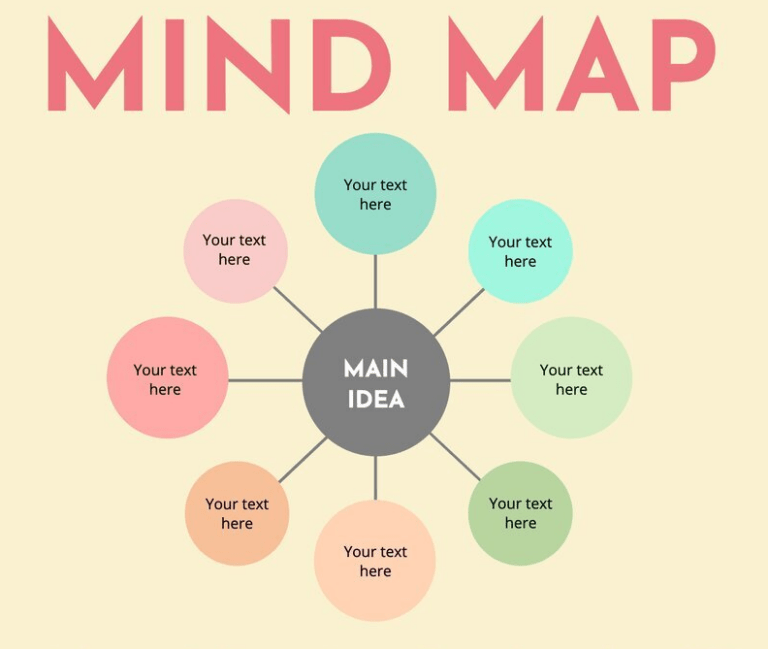Generating Ideas
Estimated Time: 15 minutes
At the end of this lesson, you will be able to use several types of idea generation strategies, such as brainstorming, clustering, and freewriting.
How Do I Think of What to Write?
Welcome to our lesson about generating ideas. In our previous video we covered how to approach a topic based on key verbs in the title. In this session we will cover the next steps in the writing process — the brainstorming part.
When you first read about a topic, your brain may start to automatically create relationships which are called “associations” between familiar key words in the text, and your previous knowledge or experience with the concepts of those words.
A simple example would be hearing the phrase “social media” — you may start thinking of instant messages, your friends, or your photos, but it may also lead to more complex associations, such as the fact that you may be spending too much time on social media, or even remember to video chat with your best friend in Thailand.
In academic writing, the process of thinking and creating mental images about aspects of the topic is important in order to be able to generate ideas for an essay, but rather than happening in a random and unconscious manner, it is organized and conscious.
There are many techniques to help you activate your previous knowledge of the topic but in this lesson, we are going to present three, which can be used alone or in combination, depending on the topic and your personal learning style. These techniques are freewriting, brainstorming, and clustering.
One of the tenets of brainstorming, free writing, and clustering is that you consider all ideas, even ones that seem silly! As you develop your ideas, you can further revise and refine them as you learn more about your topic.
You can find the PowerPoint in the video here.
So, let’s start by looking at a very simple listing topic: What are some reasons for learning a foreign language?
Although this is a familiar topic, and easy in the sense that you can come up with a few points without having to do much research, a problem you may face is the fact that although you know what to write, you find it challenging to decide how to organize your ideas and how to select which points to include. Every time you are faced with similar problems, it is helpful to be able to actually see the content of your thoughts on paper.
Freewriting is a very good way to get you started with visualizing your ideas. It involves writing down words and phrases relevant to the topic, without being concerned with grammar, order or spelling. In this sense, a freewriting sample about the topic could look something like this.

There are no particular rules for freewriting other than the fact that there are no rules. No two writing samples will look the same because each writer may have different views and different writing styles. Some writers may choose to be more detailed while some others may choose to just start by writing down disconnected words.
Freewriting helps you build confidence with topics that you are familiar with, and it also helps you discover gaps in your knowledge when dealing with unfamiliar topics. It is helpful to be able to see your ideas on paper, reflect on them, and decide whether you need to do some research and clarify certain points. In this example, the writer has already identified a few interesting themes by freewriting about the topic.
Brainstorming
The next step in generating ideas is called brainstorming, and it involves arranging some of the themes that you identified by freewriting into clearer, organized points. In this sense a brainstorming draft could look something like that:
- Learning a language for professional development
- Learning a language for studies
- Learning a language to use the internet and various software
- Learning a language to be able to read books and publications for work, study and entertainment
- Learning a language to communicate and connect to people from other countries.
As you can see here, after randomly writing down ideas the writer refined them and rephrased them to look a bit “tidier”. Note that in most cases you will have to choose a limited amount of points to include in your essay and that’s usually because of word count limitations. The best time to do that is after the next technique we will present in this lesson, which is clustering.
Clustering
Clustering is also called mind mapping and it can be seen as the next step to brainstorming as it involves generating specific ideas about the points you brainstormed. As I mentioned earlier, clustering can be useful in helping you decide what points to include in your paragraph based on the amount of information you can come up with during the process.
There are many ways to organize your ideas with this technique but the most common is writing down your points in connected bubbles which look something like the diagram below.

Check Yourself!
Answer the question below to check your understanding of today’s lesson.
Quiz Summary
0 of 1 Questions completed
Questions:
Information
You have already completed the quiz before. Hence you can not start it again.
Quiz is loading…
You must sign in or sign up to start the quiz.
You must first complete the following:
Results
Results
0 of 1 Questions answered correctly
Your time:
Time has elapsed
You have reached 0 of 0 point(s), (0)
Earned Point(s): 0 of 0, (0)
0 Essay(s) Pending (Possible Point(s): 0)
Categories
- Not categorized 0%
- 1
- Current
- Review
- Answered
- Correct
- Incorrect
-
Question 1 of 1
1. Question
Put these techniques in the order that you would use them in generating and then focusing on a single idea for your essay.
-
clustering
-
freewriting
-
brainstorming
View Answers:
CorrectIncorrect -
